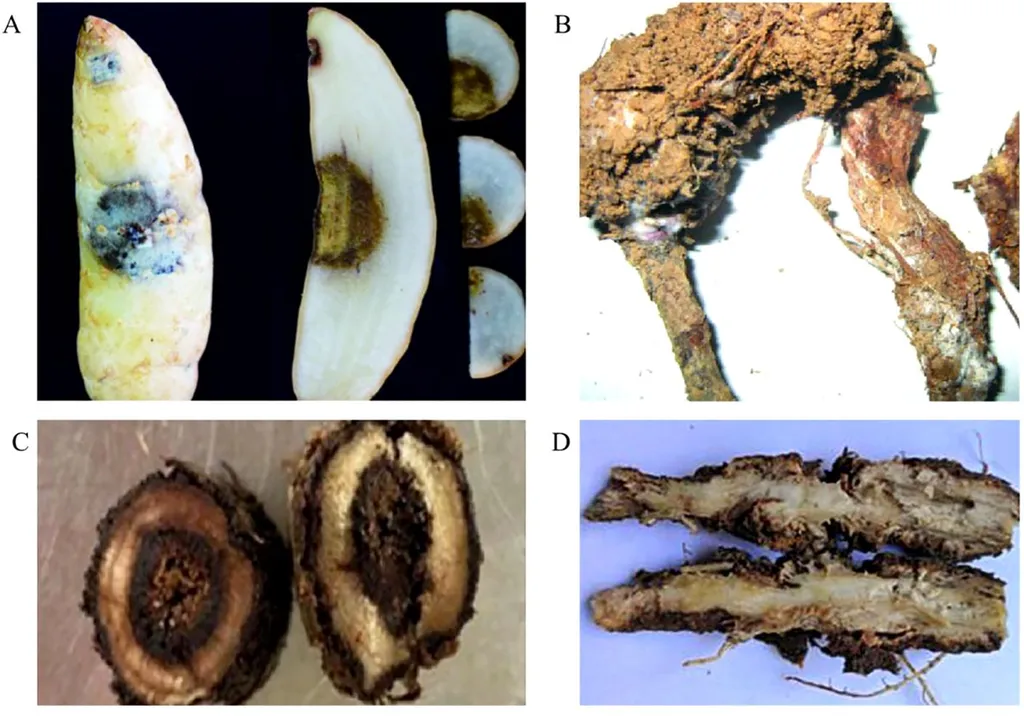In the heart of western Yunnan, a silent battle rages beneath the soil, threatening the growth of *Aconitum carmichaelii*, a plant with significant medicinal and commercial value. Researchers, led by Xingxun Dai from the College of Resources and Environment at Yunnan Agricultural University, have been working to unravel the mysteries of the plant’s root rot, a disease that has long puzzled farmers and scientists alike. Their findings, published in the journal *Microorganisms* (translated as “微生物”), offer a promising path forward for sustainable disease management and could have significant implications for the energy sector.
The team employed high-throughput sequencing to profile microbial communities across four critical niches of both healthy and diseased *A. carmichaelii* plants: rhizosphere soil, tuberous root epidermis, root endosphere, and fibrous roots. They also analyzed the physicochemical properties of the corresponding rhizosphere soils. What they found was a stark contrast between the microbial communities of healthy and diseased plants.
“We identified significant disparities in rhizosphere soil properties and bacterial and fungal community structures between healthy and diseased cohorts,” Dai explained. This discovery is a crucial first step in understanding the ecological dynamics at play.
The researchers isolated fifteen putative pathogens, spanning eight species across four genera, including *Fusarium solani*, *F. avenaceum*, *Clonostachys rosea*, and several others. Concurrently, they identified eight plant growth-promoting (PGP) biocontrol strains, notably several species of *Bacillus*, known for their beneficial effects on plant health.
One strain, *Bacillus* sp. DX3, stood out for its exceptional PGP and antagonistic capacity. In pot trials, DX3 not only enhanced soil physiochemical properties through nitrogen fixation, phosphate solubilization, and other mechanisms but also significantly promoted plant growth and boosted the plant’s resistance to root rot.
“The inoculation of DX3 elevated defense-related enzyme activities in *A. carmichaelii*, achieving over 50% disease suppression efficacy,” Dai noted. This dual functionality—promoting growth while suppressing disease—makes DX3 a promising candidate for sustainable disease management.
The implications of this research extend beyond the agricultural sector. *Aconitum carmichaelii* is a valuable plant in traditional medicine, and its sustainable cultivation is crucial for the pharmaceutical industry. Moreover, the principles of microbial ecology and biocontrol strategies developed in this study could be applied to other crops, potentially revolutionizing sustainable agriculture.
For the energy sector, the insights gained from this research could inform the development of bioenergy crops that are resilient to diseases and require fewer chemical inputs. This could lead to more sustainable and cost-effective bioenergy production, contributing to a greener energy future.
This work not only delineates key pathogenic determinants of Yunnan *A. carmichaelii* root rot but also identifies promising multifunctional microbial resources with dual PGP and biocontrol attributes. As Dai and his team continue to explore the complexities of the plant microbiome, their findings could pave the way for innovative and eco-friendly solutions to some of the most pressing challenges in agriculture and energy production.

